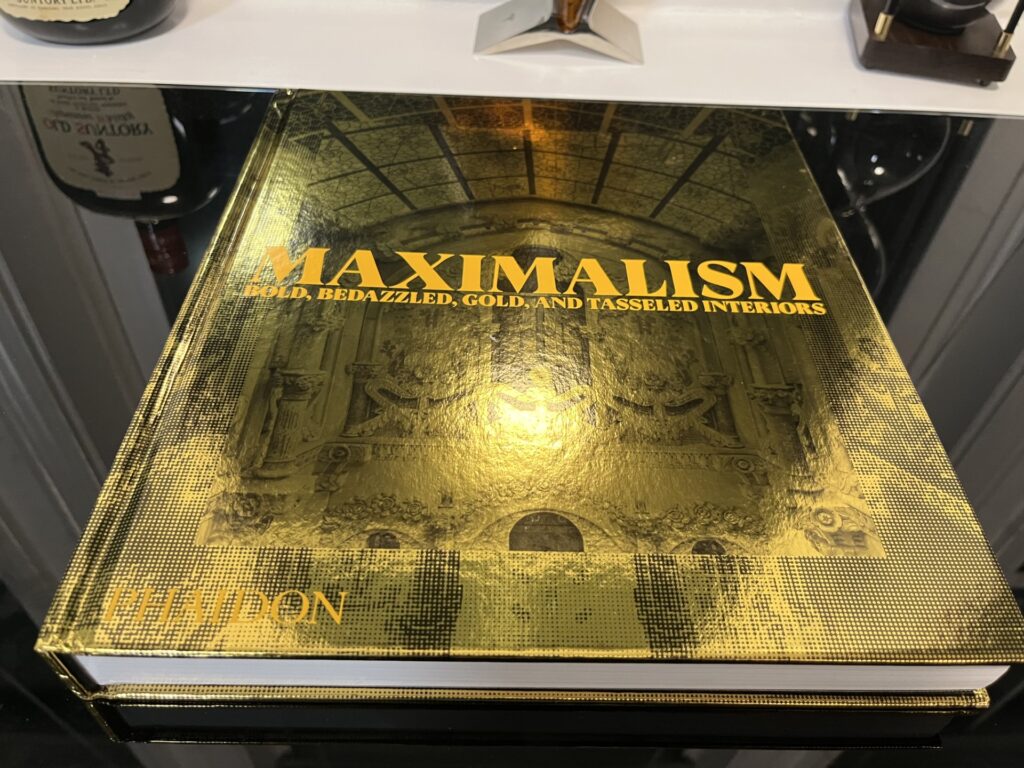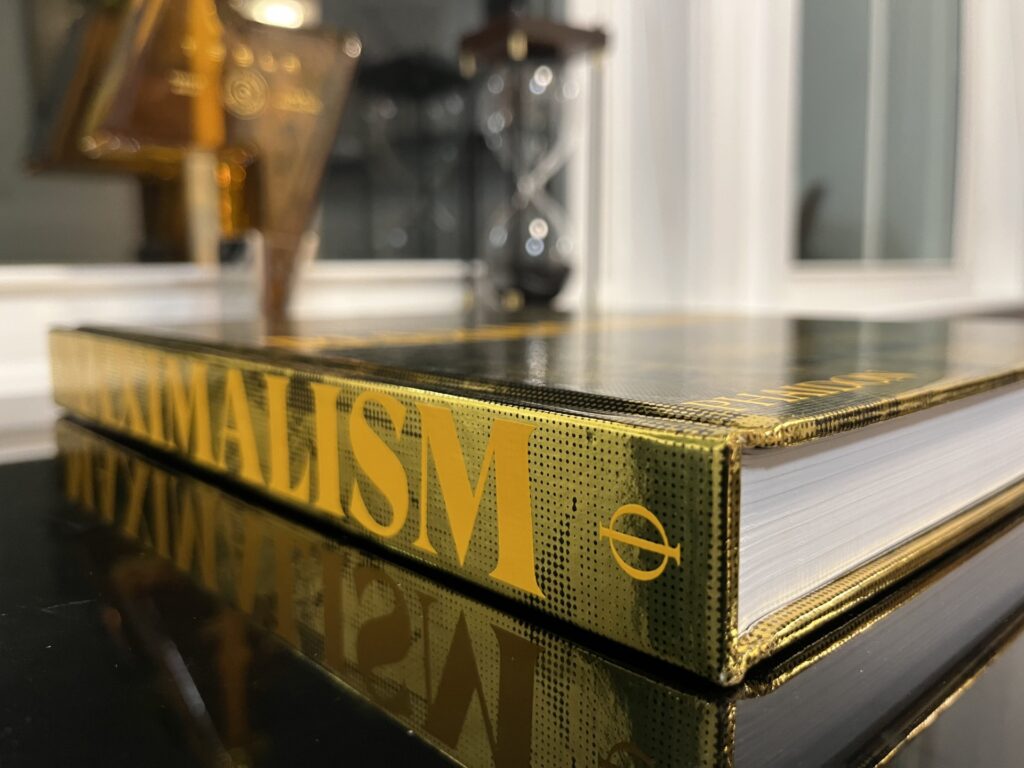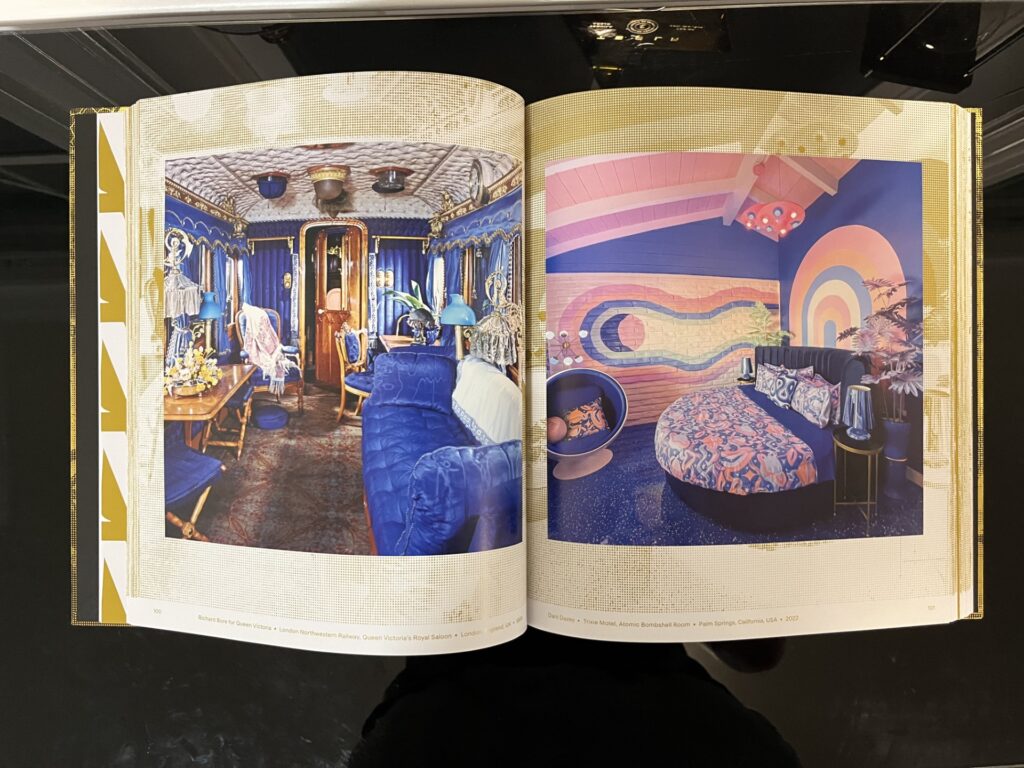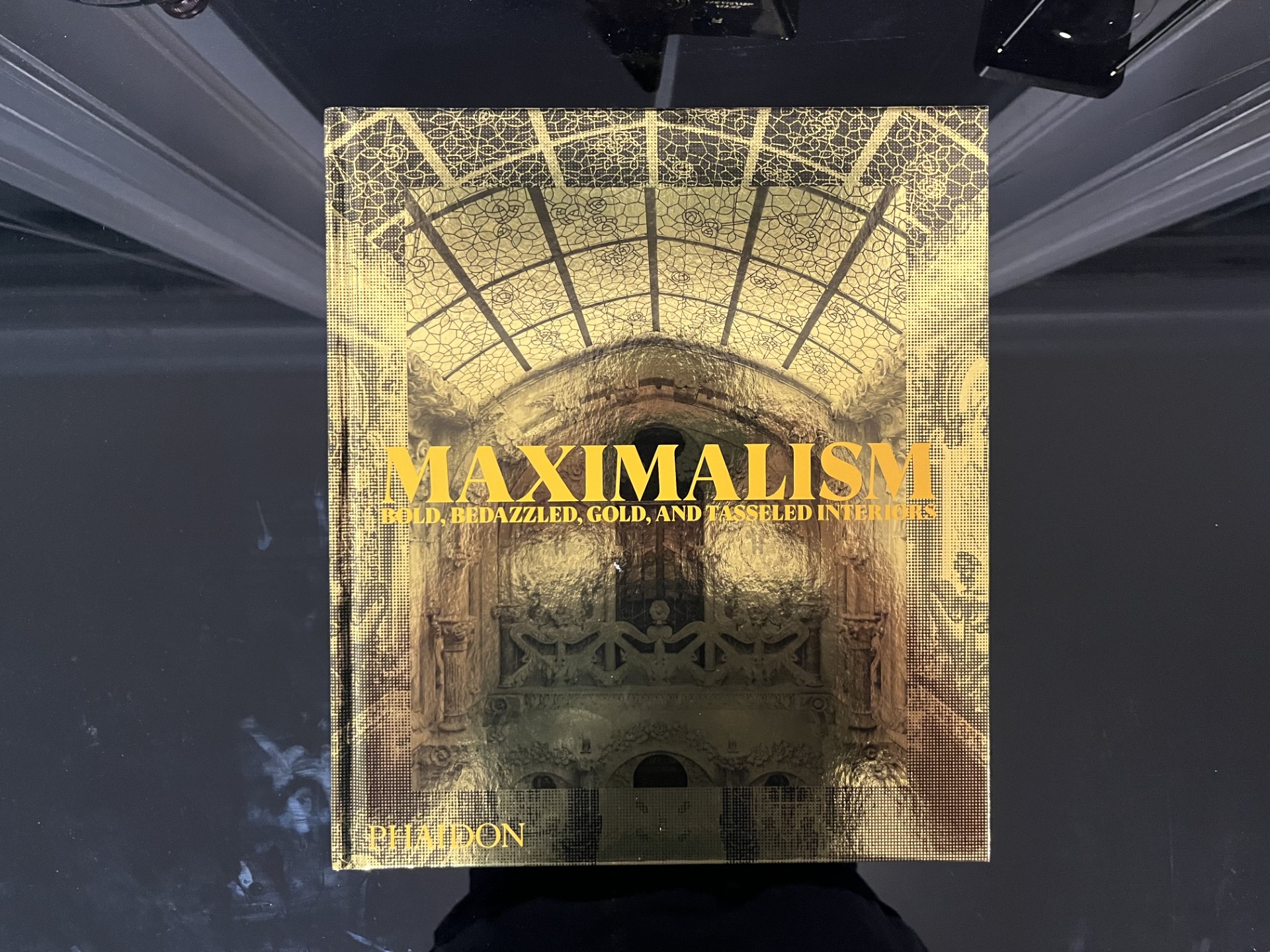The world of interior design is often dominated by minimalism, but a new coffee table book, “Maximalism: Bold, Bedazzled, Gold, and Tasseled Interiors,” invites readers to embrace a more vibrant and eclectic style. This book showcases how maximalism can transform spaces into colorful, layered environments that reflect personality and history. With its stunning visuals and rich textures, it serves as both inspiration and a celebration of artistic freedom in home decor.
Readers will find a thrilling exploration of interiors that defy norms and celebrate individuality. Each page offers a glimpse into the bold choices and intricate details that define maximalism, making it a perfect addition to any design lover’s collection. From luxurious fabrics to intricate patterns, this book illustrates how combining elements can create an inviting and dynamic atmosphere.

In a time when many seek comfort and warmth in their homes, “Maximalism” provides an exciting reminder that a home can be both lively and welcoming. It encourages everyone to experiment with their space and to embrace the beauty of bold design choices. This book is not just a guide; it’s an invitation to make every corner of a home reflect personal style.
The Essence of Maximalism
Maximalism is a vibrant and layered design style that embraces abundance and personality. It stands in contrast to minimalism, focusing on bold colors, rich textures, and eclectic decorations.
Defining Maximalism
Maximalism is characterized by its lively and often chaotic aesthetic. It encourages individuals to express their uniqueness through their living spaces. This style often incorporates a mix of patterns, colors, and materials.
Key elements include:
- Color: Bright and saturated hues are prominent.
- Texture: A variety of fabrics like velvet, silk, and fur add depth.
- Layering: Items are stacked or grouped to create visual interest.
Maximalism allows for personal storytelling through decor, blending art, antiques, and contemporary pieces.
Historical Evolution
Maximalism has roots that stretch back over 400 years, influencing various design movements. Originating in grand palaces and historic homes, it captured the lavishness of different eras.
From the Baroque period, known for its opulence, to the Victorian era with its diverse influences, maximalism has evolved. In modern contexts, it embraces global inspirations, incorporating elements from various cultures.
This evolution showcases how maximalism adapts while celebrating excess and individuality. It remains a testament to the joy of creativity, inviting bold choices in home decor.
Design Principles
In maximalism, design principles focus on the use of strong patterns, vibrant colors, and rich textures. These elements work together to create an environment that feels alive and full of character.
Embracing Bold Patterns
Bold patterns are a hallmark of maximalist design. They can appear in wallpapers, textiles, and decor items.
Large florals, geometric shapes, or abstract prints add energy to a room. Mixing various patterns creates visual interest. For example, pairing a striped sofa with floral pillows can create a dynamic look.
To successfully embrace bold patterns, it’s crucial to maintain a balance. Too many competing designs can overwhelm the space. Thoughtful layering can work wonders, allowing each piece to shine while still feeling cohesive.
Color Palette Exploration
Color plays a significant role in maximalism. A diverse color palette often includes vibrant hues alongside softer tones.
Common choices might involve jewel tones like emerald green, deep blue, and rich gold. Using unexpected color combinations can lead to stunning results.
Accent walls and artwork can serve as focal points. This technique enables the use of multiple colors without making the space feel chaotic. Including neutrals can ground the overall look, preventing it from becoming overwhelming.
Layering Textures and Fabrics
Layering different textures and fabrics adds depth and warmth to maximalist interiors. Combining smooth surfaces with plush fabrics creates a cozy atmosphere.
For instance, pairing a velvet sofa with a chunky knit throw can make a space inviting. Sheer curtains can provide softness while allowing natural light to filter in.
Incorporating various materials, such as wood, metal, and glass, enhances the richness of the design. This approach creates a tactile experience that invites interaction. Mixing textures can also add a sense of history and personality to a room.
Maximalist Icons
Maximalism celebrates bold designs and vibrant details that inspire creativity. This section highlights influential designers who have shaped this style and showcases notable rooms that exemplify maximalist principles.
Influential Designers
Several designers have made significant impacts on the world of maximalism. David Hicks is known for his colorful patterns and use of lavish materials. His work often combines eclectic elements, making spaces vibrant and striking.
Alessandra Branca embraces bold color and rich textures, creating inviting atmospheres. She blends classic styles with modern touches. Her designs often feature an array of textiles and artwork, enhancing the maximalist aesthetic.
Jonathan Adler brings a playful approach with his quirky accents and unique pottery. His spaces burst with energy, often mixing different styles and eras. These designers inspire many to embrace the joy of maximalism in their homes.
Iconic Rooms and Spaces
Some rooms exemplify the charm of maximalism beautifully. The Parlour at the Victoria & Albert Museum in London is a striking example. It showcases a vibrant mix of colors, patterns, and styles alongside historical elements.
Another notable space is the Biba Boutique in London, which features dramatic wallpaper and bold displays. This space creates an immersive experience that captures one’s attention.
The Jean Paul Gaultier Boutique in Paris offers a blend of avant-garde design and classic style. Its colorful textiles and eclectic pieces enhance the sensation of maximalism. Each room mentioned invites exploration and appreciation for the art of design.
Key Elements
Maximalism celebrates bold choices and unique style. The book “Maximalism: Bold, Bedazzled, Gold, and Tasseled Interiors” highlights several key elements that define this lively design approach.
Statement Pieces
Statement pieces are crucial in maximalist design. These items grab attention and often become the focal point of a room. They can include oversized artwork, bold furniture, or even intricate lighting.
For instance, a large abstract painting can set the tone for the entire space. When selecting these pieces, contrasting colors and patterns work well together to create a sense of drama.
Maximalism encourages mixing styles, so a vintage chair can pair perfectly with modern art. The key idea is to choose items that resonate personally, making the space feel unique and lively.
Mixing and Clashing
Mixing and clashing different styles and patterns defines maximalism. This approach allows for creativity and personal expression in interior design. Bold florals can coexist with geometric shapes, creating a dynamic visual experience.
Layering textures also plays a significant role. A plush velvet sofa can sit alongside a sleek metal coffee table. The goal is to create a harmonious yet exciting environment that reflects the owner’s personality.
Using various color palettes also enhances this mix. Bright hues can contrast beautifully with muted tones, adding depth to the space. This blending of elements brings energy and character to every corner of a home.
The Role of Gold
Gold elements add a touch of luxury and sophistication to maximalist interiors. This metallic hue can be incorporated through fixtures, furniture, or accessories. For example, gold-leafed mirrors or ornate chandeliers create a stunning visual impact.
Gold works well as a complement to both bold colors and subtle tones. It reflects light, enhancing the overall atmosphere of a room. This shimmering aspect adds warmth and elegance, drawing attention without overwhelming the space.
When combined with other textures, like wood or fabric, gold can elevate the design. It’s essential to use it thoughtfully to maintain balance and avoid a cluttered look. Proper placement allows gold accents to shine while enhancing the overall theme.
Accessorizing With Tassels
Tassels are a playful and charming element in maximalist decor. They can be used in various ways, from throw pillows to curtains. These additions bring a touch of whimsy, adding movement and flair to a room.
Incorporating tassels allows for personalization through color and material choice. They can match existing decor or stand out as a statement element. Vibrant tassels can contrast beautifully with neutral tones.
Using tassels in different lengths and styles creates visual interest. A tasselled throw blanket can add texture while making a space feel cozy. This element is perfect for those who appreciate detail and craftsmanship in their interiors.
Creating Maximalist Interiors
Maximalist interiors embrace bold styles and personal expression. This approach allows for a rich blend of colors, textures, and patterns across different rooms. Here are some key strategies to achieve this lively aesthetic.
Room-by-Room Guide
To create a maximalist design, start by thinking about each room individually. In the living room, mix vibrant patterns on pillows and rugs. Layered curtains can add depth, while colorful artwork creates focal points on the walls.
In the bedroom, bold bedding paired with eclectic décor items can enhance the sense of style. Use a mix of prints for the bedspread and throw pillows. Don’t forget to add personal touches like framed photos or unique trinkets to make it cozy.
The kitchen can be playful with colorful dishware and open shelving. Displaying well-loved cookbooks along with quirky kitchen tools adds charm. Finally, a maximalist bathroom could feature bright towels, patterned shower curtains, and decorative items that reflect her personality.
Balancing Harmony and Contrast
Creating a harmonious yet vibrant environment is key in maximalism. To achieve this, work with a balanced color palette. Choosing three to five colors can help in maintaining unity while allowing for bold choices.
Contrast is important too. Mixing different textures like wood, metal, and fabric can create visual interest. For instance, a glossy ceramic vase on a matte wood table can make both elements pop.
When combining patterns, ensure that they share at least one common color. This way, various prints can coexist without clashing. It’s all about creating a space that feels cohesive and dynamic at the same time.
Incorporating Personal Collections
In maximalist interiors, personal collections are valuable. They tell a story and reflect individual interests and experiences. Showcase your collection of travel souvenirs or vintage books in a dedicated space.
Using open shelves or glass cabinets can display these items beautifully. Arranging objects by size or theme can also provide an organized look. This method keeps the space inviting and uncluttered, despite the abundance of items.
Incorporating collections can extend beyond display. Items like colorful plates can serve as wall art. Accessories and memorabilia can bring warmth and personality to any room, turning your home into a unique reflection of yourself.
Photography and Presentation

The book “Maximalism: Bold, Bedazzled, Gold, and Tasseled Interiors” showcases stunning photography that captures the essence of maximalist design. Each image emphasizes rich colors and intricate patterns that invite the viewer to explore each space.
The layout is thoughtfully designed to enhance the visuals. Clean lines and ample white space help draw attention to the vibrant interiors. The combination of photographs provides a vivid journey through various styles and eras.
The book features over 220 carefully curated images. These images highlight luxurious textures and bold decor choices. Readers can truly appreciate the creativity that defines maximalist interiors.
The presentation complements the theme beautifully. Each page feels like a celebration of style and imagination. The high-quality printing brings out the details, allowing every nuance to shine.
Case Studies

Exploring specific examples of maximalist design reveals the colorful creativity and dramatic style intrinsic to this aesthetic. These projects illustrate how living spaces can transform into vibrant statements filled with personality and flair.
Renowned Maximalist Projects
One prominent example is the work of Jonathan Adler, who is famous for his bold use of patterns and colors. His New York apartment showcases layered textiles, eclectic furnishings, and eye-catching art pieces.
Another striking project is the Eden Rock Resort in St. Barths. This luxurious destination blends bright colors, lush textures, and elaborate décor. It embodies the fundamental essence of maximalism, inviting guests into a world of lush sophistication.
Additionally, the Vogue House in London displays a dramatic fusion of vintage and contemporary styles. Rich fabrics and ornate details highlight the elegance typical of maximalist spaces.
Transformation Stories
Homeowners often undergo remarkable transformations when embracing maximalism. For instance, a couple in San Francisco transformed their minimalist loft into a vibrant sanctuary. They introduced bold wallpaper, colorful furniture, and multiple art pieces, creating a lively atmosphere.
In another case, a traditional Victorian home in London was reimagined using maximalist principles. Designers replaced muted tones with bright, playful colors and added diverse decorative items.
These transformations showcase how spaces can be revitalized, reflecting the owner’s personality and style. Each project emphasizes a willingness to embrace excess and creativity in design.
